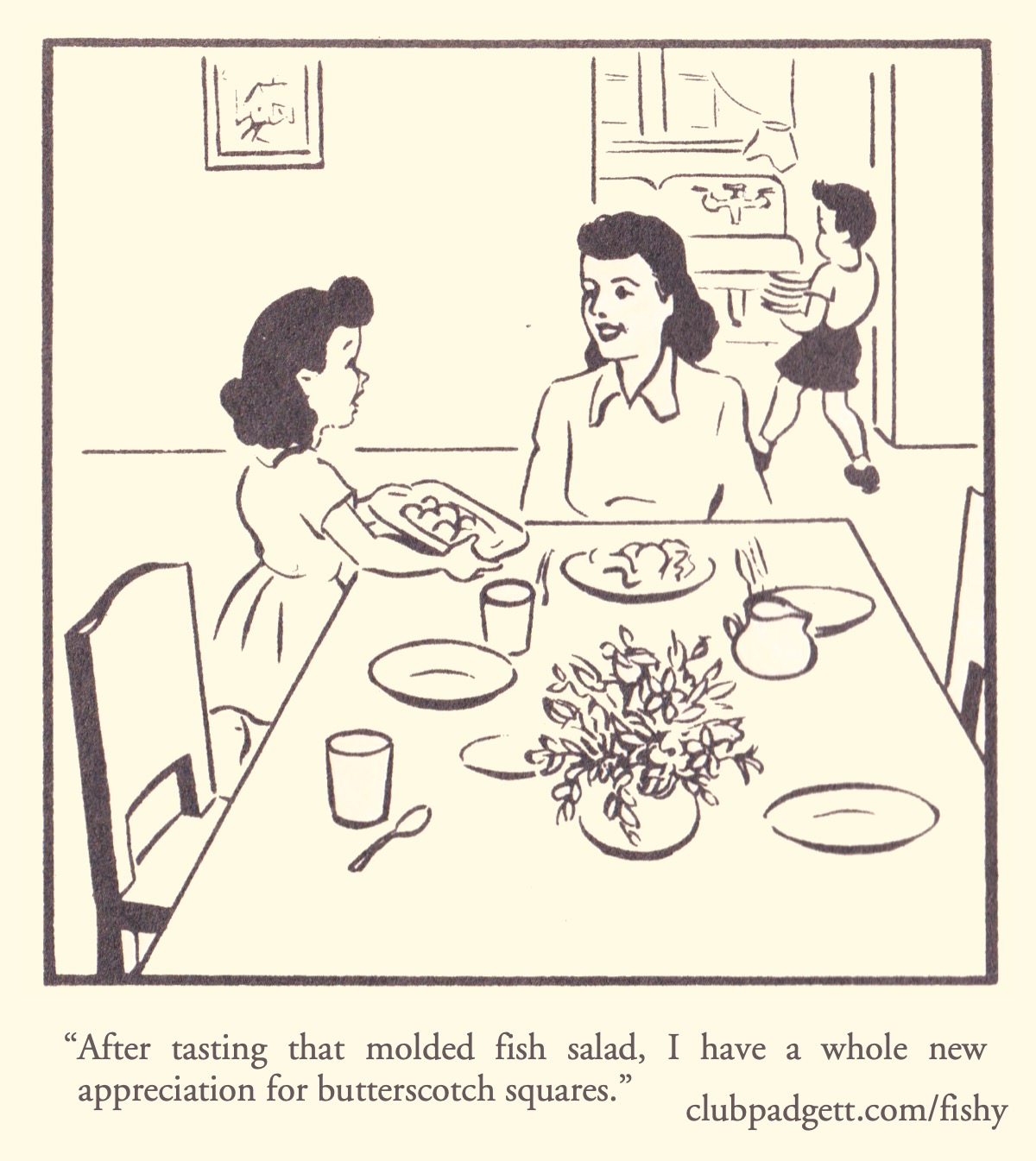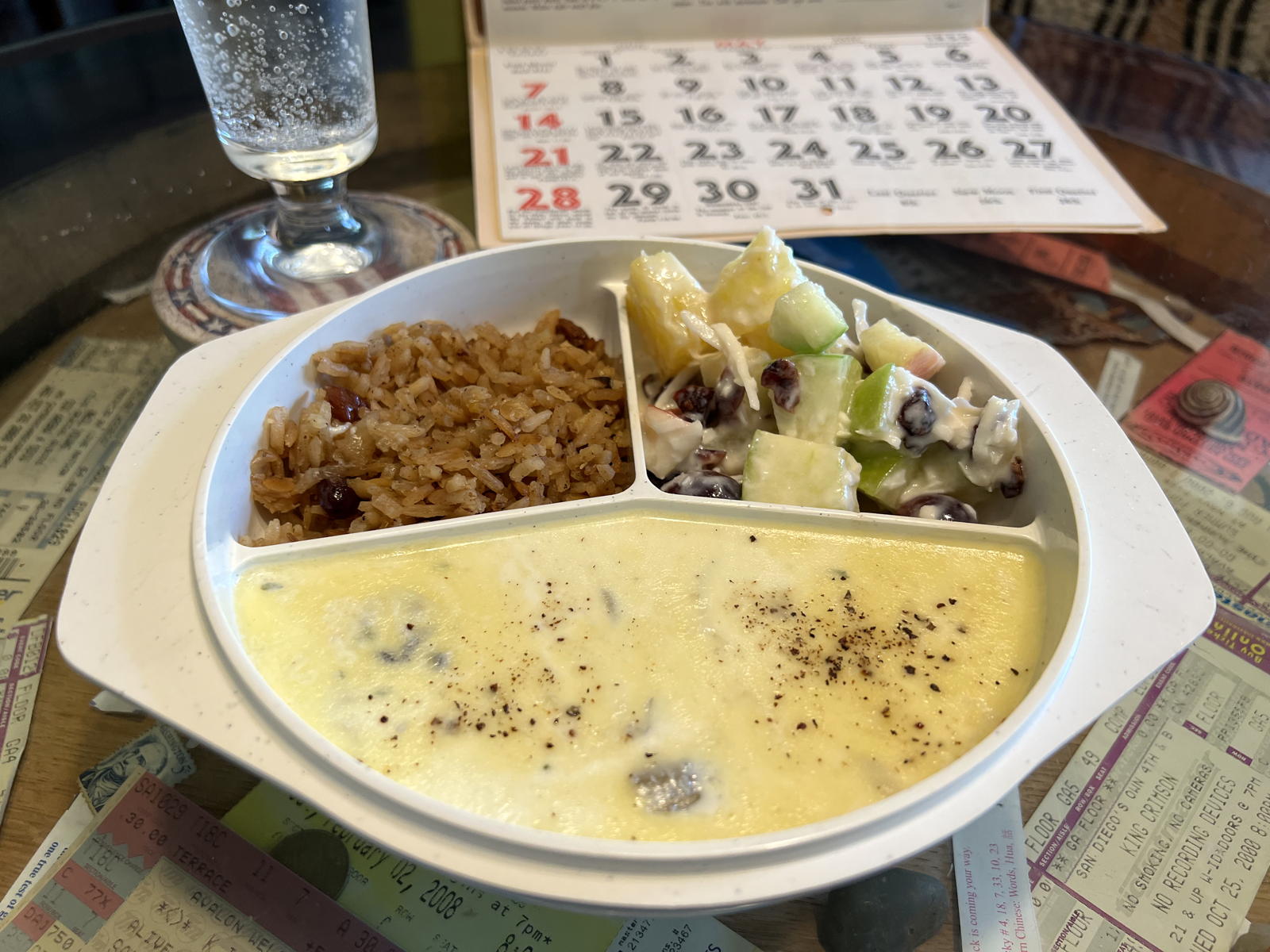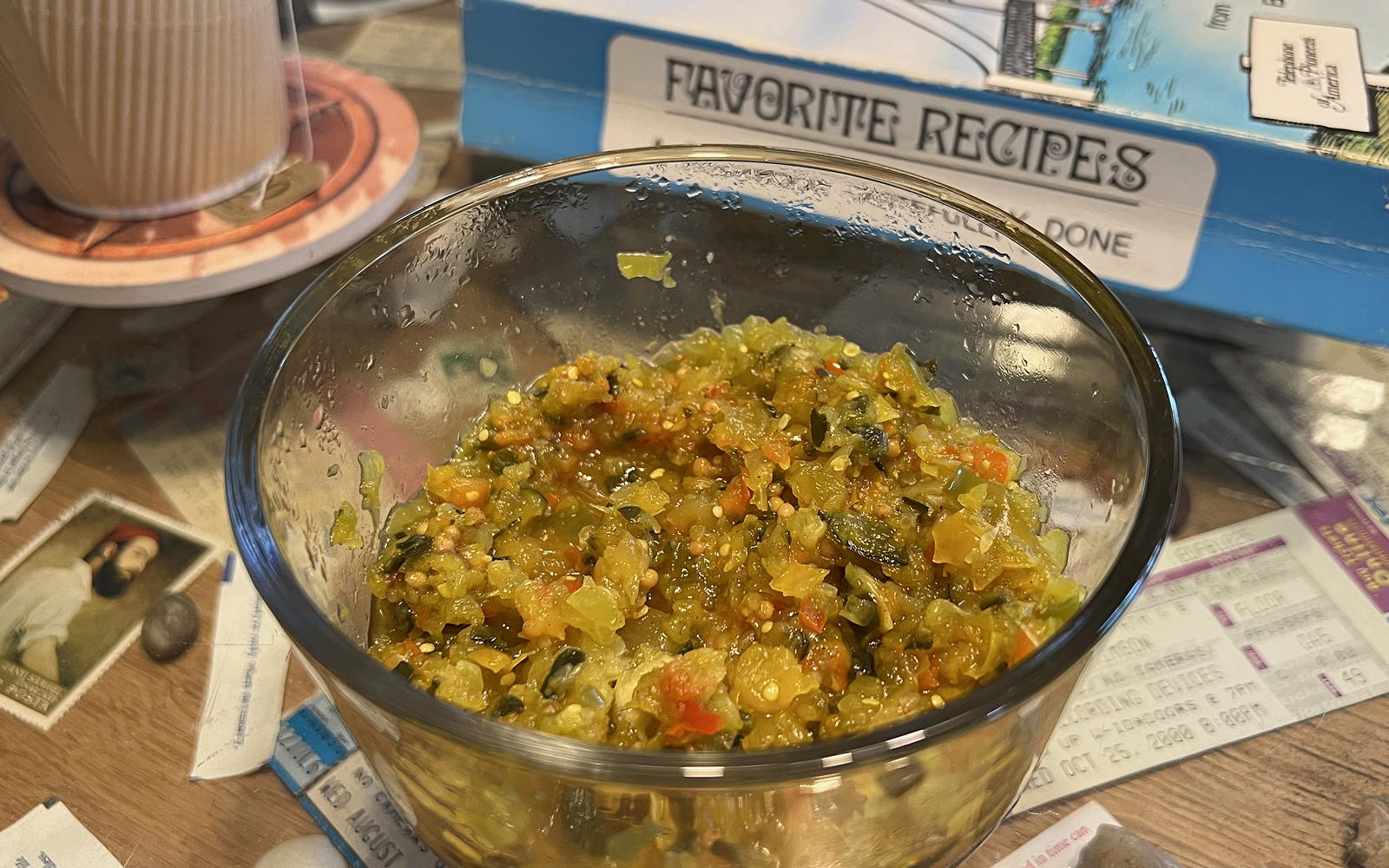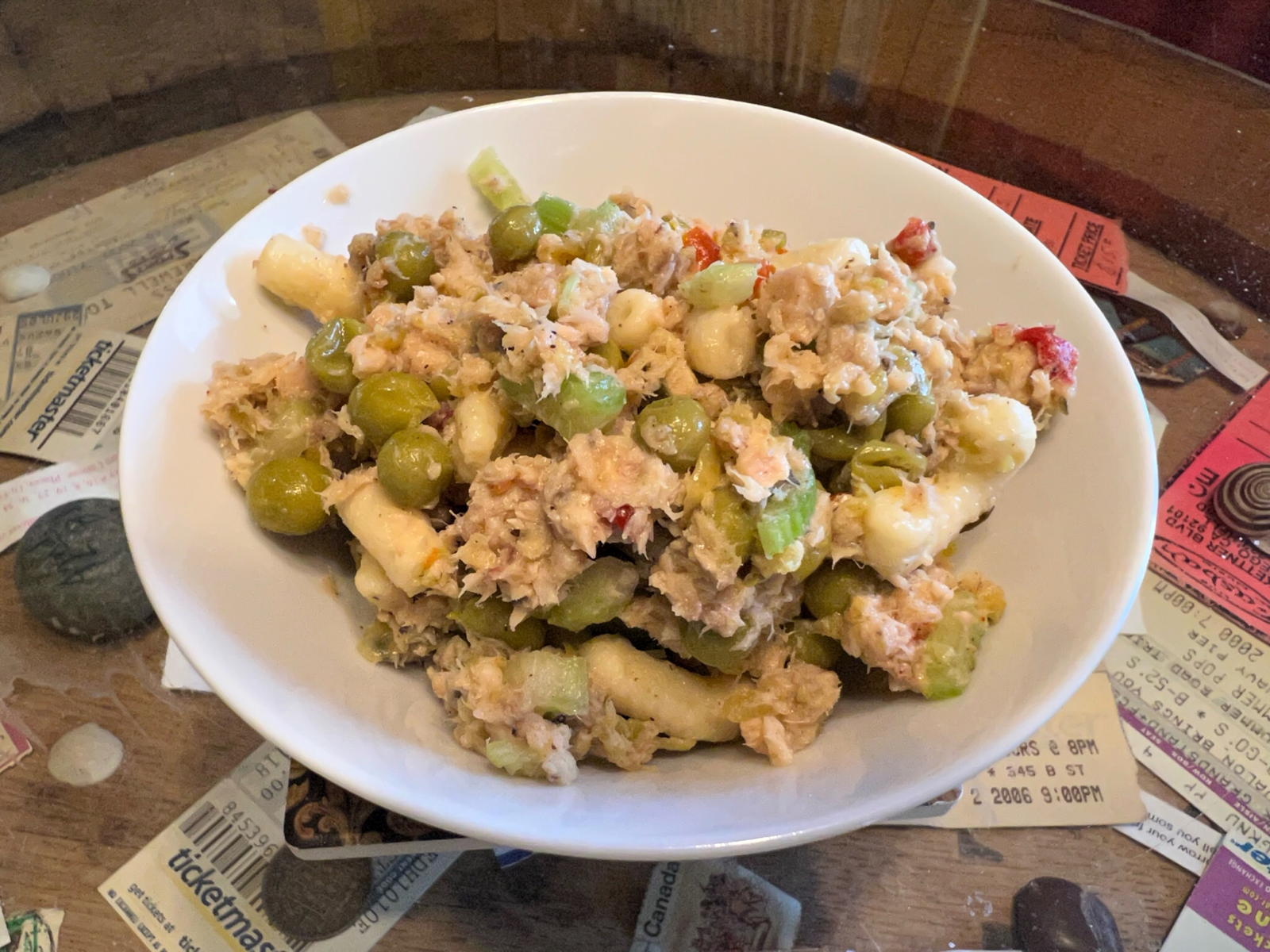Something fishy in the state of Wisconsin

You and me both, mom.
The fish dishes continue into May in the Hope Lutheran 1950 calendar (PDF File, 11.7 MB). For April, I made the Oyster Stew and the Salmon Salad. For May, I made the Molded Fish Salad.
I was very pessimistic about the Molded Fish Salad, but the reality exceeded my wildest fears.
April’s fish recipes were very easy, tasty, and worth remembering. They were, like the Shrimp Spaghetti I wrote about in the parent post, meant to be made quickly and from canned ingredients. There are a lot of fish recipes in this calendar, mostly from cans. This is the first time I’ve used canned oysters, and the first time I’ve used canned salmon. I was pleasantly surprised by both.
The oyster stew and salmon salad were part of the “Easter season of celebration”. I had actually thought about making the Chocolate Marble Cake in April, but I have some other chocolate cakes I want to try more, and I also already had too many baked goods on my schedule.
Further, the Salmon Salad helped me use up two items in my refrigerator, half of a tiny jar of pimentos and the tiny bit remaining in a jar of my homemade India Relish from a 1981 Michigan cookbook.
You can see the butter in the oyster stew. It gives the milk and cream an almost cheese-like color. And of course you can taste it, too. This is a very rich stew for such a quick meal.
It also features a very old-school technique. When you’re done with the stew, you don’t just remove the bay leaf, you also remove the onion and parsley. Like the bay leaf, they’re used to flavor the soup, not to texture it. It’s a creamy soup whose only texture is its creaminess and the very buttery oysters.

All that yellow is butter, wonderful butter! It’s a good soup with rice and fruit salad.
I was pretty sure that, as long as the canned oysters were good the oyster stew would be good. I was less sure of the salmon salad. In fact, I really like salmon and was afraid of wasting some on a bad recipe. But as I said above, the recipe helped empty my fridge of two almost-empty jars. That was a very serendipitous coincidence.
It’s basically a macaroni salad. The recipe calls for elbow macaroni; that’s pretty much what I used. One serving of homemade pasta made just enough macaroni for the recipe, and macaroni from an Atlas macaroni extruder pretty much automatically elbows.
I wasn’t sure about the combination of vegetables either: canned peas, celery, pimento, and sweet pickle… the latter three are flavors I was comfortable with, but peas with those seemed a risk. But the flavors blended very nicely, and the peas added not just an earthy flavor but a nice color to the salmon, macaroni, and pimento.
It’s a nice, solid, potluck style salad. I’d probably add onion if I made it again.
The pleasant surprises were not to last. May’s Molded Fish Salad was a whole new level of I-will-not-be-eating-this-again. It takes a cup of tomato juice flavored with “whole mixed spices”. Whole mixed spices is an exotic, Indian, blend of various spices that may include cinnamon, coriander, cumin, pepper, fenugreek, ginger, cloves, and/or cardamom. I suspect it’s similar to the spices that go into making ketchup.
Without the gelatin, it would probably not be a bad mix.
The recipe calls for 1-½ cups cooked fish, so I baked the last of the tilapia in my freezer; on its own, the baked fish was good, and might have been great with a stir fry of rice, those spices, celery, and green pepper.
With the gelatin, however, it was… not good. I will say it was far better than it looked, but as you can see from the photos that is not a high bar. I ended up throwing it out. The gelatin kept the flavors of the vegetables from blending, making it in a very weird way unflavored. But where the gelatin really made it worse was with the tomato juice. Gelled tomato juice has a combination of texture and flavor that, for me, simply does not go together.
I will use canned oysters and canned salmon again, in these two recipes and in others. I am not likely to make any tomato-based gelatins again. Even the fresh fish was unable to save that dish.
It makes a great photo entry in the “the past is another country” sweepstakes, however. I’m glad I made it, just to know. I see these kinds of gelatin recipes and I wonder about them. Is there some saving grace to them that I can’t see just be reading the recipe?
In this case, the answer is no, but sometimes there is. The Jellied Supper Ring in Montgomery Ward’s 1942 Cold Cooking was very tasty. It wasn’t as good as the same ingredients sans gelatin, but making those ingredients more tasty likely wasn’t the point of the recipe. Stretching those ingredients was. Without the gelatin, it would have been a very good ham salad for two people. With the gelatin, it was a very good ham salad for six people.
In my opinion, this gelatin would be a very good tomato salad for infinite people, because no one’s going to eat it.
I will add that I think I finally have the hang of unmolding salads like this. It takes patience, far more patience than I’ve exhibited before. After taking the mold out of the fridge, I turned it upside down on a plate and simply waited. I didn’t try dipping it in warm water like I normally do. I did microwave a wet paper towel and lay that on top of the mold, because I wanted to reduce the chance that the top would stick and the bottom would not, causing a broken mold. I reheated the paper towel twice.
After about fifteen minutes I went to reheat the paper towel again and the mold felt very light. I hadn’t heard it, but the salad had fallen out to the plate perfectly. It didn’t look like some half-melted creature from a fifties horror flick that my gelatins so often do. It looked like something out of a horror movie for entirely different reasons.
So, this recipe did do one thing for me: I’ll be far less afraid to use molds for future gelatin recipes that I do enjoy.
May has at least one nice recipe on it: I made the Butterscotch Squares when initially evaluating the calendar. They’re great, especially if you enjoy bran muffins and other bran baked goods. The Peach Meringue Crown—which was my choice for May before I decided on a fish post—looks great, and easy. I’m sure I’ll be making it at some point.
May’s theme is “A Dinner Surprise for Mother”. I expect that any mother presented with these dishes ate a whole lot of butterscotch squares and peach meringue, not so much the molded fish salad. But who knows? These recipes were ubiquitous up to the seventies. Somebody must have enjoyed them.
While the salmon salad recipe calls for “chopped sweet pickle”, I used this very versatile “India Relish”. I continue to be pleasantly surprised by how useful this alternative relish is. I found it in a 1981 cookbook from Michigan telephone operators. I’ve used it on hot dogs, on hamburgers, even on its own as a small side to cheese and fruit, and egg and potatoes.

India Relish
Servings: 3
Preparation Time: 1 hour, 30 minutes
Dianna Shumsky
Review: Favorite Recipes (A Cookbook Tastefully Done) (Jerry@Goodreads)
Ingredients
- 3 large red bell peppers
- 1 large green jalapeño pepper
- 1 little red chili pepper
- 6 green tomatoes
- 3 cucumbers
- 1 large onion
- 3 tbsp salt
- 1 cup cabbage
- 1-¼ cup sugar
- 1-½ cup vinegar
- 1-½ tbsp mustard seed
- ½ tsp turmeric
- ¼ tsp ground mace
- ½ tsp cinnamon
- 1 tsp ground ginger root
- 1 large bay leaf, crushed lightly
Steps
- Remove the seeds from the peppers.
- Put the peppers, tomatoes, cucumbers, and onions through a meat grinder, using the small blade.
- Stir the salt into the vegetables.
- Let sit on the counter overnight.
- Place vegetables in a colander and press down firmly to force out as much brine as possible.
- Grind cabbage.
- Combine with the ground vegetables.
- Place over low heat and slowly heat only to simmering; occasionally stir, gently, until vegetables are slightly tender.
- Add the sugar, vinegar, and spices and heat to boiling.
- Boil three minutes.
- Pack in warm jars and seal with a water bath.
In response to A 1950 recipe calendar for 2023: In October, a friend gave me this cool calendar of recipes from 1950. It turns out, 1950 is the same as 2023, right down to the date of Easter. Print it out and hang it if you wish, and happy New Year!
- Review: Cold Cooking: Jerry Stratton at Jerry@Goodreads
- This 1942 Montgomery Ward cookbook not only tries to convince you to buy a refrigerator, but to use it year-round. Ice creams are one of the best way to do that.
- Review: Favorite Recipes (A Cookbook Tastefully Done): Jerry Stratton at Jerry@Goodreads
- “This is an amazing snapshot of food in Michigan in 1981, which probably means the seventies. It’s nominally a statewide collection, but the focus is on two chapters of the Telephone Pioneers of America, the Great Lakes Chapter (based in Grand Rapids) and the Wolverine Chapter (based in Detroit).”
More fifties
- Looking back over 1950 in vintage cooking
- While I didn’t make my goal of trying a recipe every month in the month it was meant for, following this calendar through 2023 was an interesting experience and provided some very good food.
- El Molino Best: Whole grains in 1953
- El Molino Mills of Alhambra, California, published a fascinating whole grain cookbook in 1953.
- 1950 Cherry Pudding Dessert
- A vanilla-almond custard covered with a thick cherry sauce, from a 1950 recipe calendar.
- January birthday veal from 1950
- The Veal Rolls from the 1950 recipe calendar of Hope Lutheran Church in Chicago.
- A 1950 recipe calendar for 2023
- In October, a friend gave me this cool calendar of recipes from 1950. It turns out, 1950 is the same as 2023, right down to the date of Easter. Print it out and hang it if you wish, and happy New Year!
More fish
- Hope Lutheran 1950 Lenten fish au gratin
- One of the interesting things about old calendars that are also something else—such as a cookbook—is that they follow seasons that no longer exist.
- Salmon Curry Soup
- Very easy to make, this is a bright, beautiful, delectable cream of salmon soup. The yogurt and spices give it an almost lemony taste.
- Bacon scallops in dill sauce
- A bit fiddly, these bacon-wrapped scallops make a great party snack.
- Corn and clam soup
- Corn and clam soup with spinach, shrimp, and red bell pepper. Fast and easy.
- Hot tuna quinoa
- A bit of jalapeño, olives, wine, and fresh lime flavors and tuna and highlights the quinoa.
- One more page with the topic fish, and other related pages
More food history
- Mrs. Winslow’s Domestic Receipt Book for 1876
- If this is what people were eating in 1876, they were eating very well. From coconut pie to molasses gingerbread to tomato jam, these are great recipes—albeit requiring some serious interpretation.
- The New Centennial Cook Book
- Over 100 Valuable Receipts for Cakes, Pies, Puddings, etc.… borrowed verbatim from other cookbooks.
- Quiet ovens and Australian rice shortbread
- What is a quiet oven? How do we translate old recipes? Executive summary: 325°; very carefully. Plus, two Australian recipes for rice shortbread as a test of my theory.
- Stoy Soy Flour: Miracle Protein for World War II
- To replace protein lost by rationing, add the concentrated protein of Stoy’s soy flour to your baked goods and other dishes!
- Vintage cookbook reproductions, and gold cakes compared fifty years apart
- I’m going to start producing facsimiles of some of the vintage cookbooks I’m covering here, because some of them are wonderful, and also because it’s easier to read them in a larger format.
- 18 more pages with the topic food history, and other related pages


